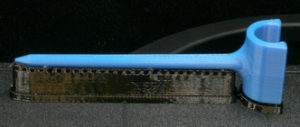Rapid Prototyping
 No one likes surprises. Sometimes when just viewing a CAD model it can be easy to overlook some details or have a different idea of how the part will look and feel. So although a rapid prototype isn’t completely necessary for production it is a very valuable step in the process because it allows the feel and fit to be tested with a real, actual plastic part in your hand.
No one likes surprises. Sometimes when just viewing a CAD model it can be easy to overlook some details or have a different idea of how the part will look and feel. So although a rapid prototype isn’t completely necessary for production it is a very valuable step in the process because it allows the feel and fit to be tested with a real, actual plastic part in your hand.
Rapid prototypes are useful as a way to double-check a design — makes sure everything fits and functions as it was designed. It also can act as a design aid as you may use the model to check the aesthetics or function in an iterative design flow.
There are some minor drawbacks to the prototypes. Since the layers are around .010″ thick, the parts tend to have a stepped texture – particularly along curved surfaces. This can be minimized through post-process techniques such as sanding and filling, but for most applications it is an extremely minor issue. Also at issue is the relative frailty of the parts. Being used to injection molded thermoplastics, most people are surprised when they find they can break the prototypes apart with their hands. Unfortunately the layering process does not allow for the same internal bonding to occur as it does in traditional methods, but a little care – especially with skinny features – will ensure that you prototype remains intact.
